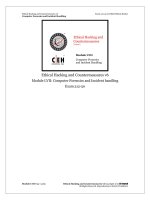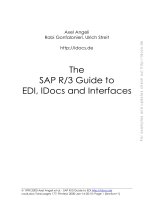Guide to Computer forensics and investigations Chapter 2
Bạn đang xem bản rút gọn của tài liệu. Xem và tải ngay bản đầy đủ của tài liệu tại đây (456.51 KB, 63 trang )
Guide to Computer Forensics
and Investigations
Fifth Edition
Chapter 3
Data Acquisition
Objectives
• List digital evidence storage formats
• Explain ways to determine the best acquisition
method
• Describe contingency planning for data acquisitions
• Explain how to use acquisition tools
Guide to Computer Forensics and Investigations Fifth Edition
© Cengage Learning 2015
2
Objectives
• Explain how to validate data acquisitions
• Describe RAID acquisition methods
• Explain how to use remote network acquisition
tools
• List other forensic tools available for data
acquisitions
Guide to Computer Forensics and Investigations Fifth Edition
© Cengage Learning 2015
3
Understanding Storage Formats for
Digital Evidence
• Data in a forensics acquisition tool is stored as an
image file
• Three formats
– Raw format
– Proprietary formats
– Advanced Forensics Format (AFF)
Guide to Computer Forensics and Investigations Fifth Edition
© Cengage Learning 2015
4
Raw Format
• Makes it possible to write bit-stream data to files
• Advantages
– Fast data transfers
– Ignores minor data read errors on source drive
– Most computer forensics tools can read raw format
• Disadvantages
– Requires as much storage as original disk or data
– Tools might not collect marginal (bad) sectors
Guide to Computer Forensics and Investigations Fifth Edition
© Cengage Learning 2015
5
Proprietary Formats
• Most forensics tools have their own formats
• Features offered
– Option to compress or not compress image files
– Can split an image into smaller segmented files
– Can integrate metadata into the image file
• Disadvantages
– Inability to share an image between different tools
– File size limitation for each segmented volume
• The Expert Witness format is unofficial standard
Guide to Computer Forensics and Investigations Fifth Edition
© Cengage Learning 2015
6
Advanced Forensics Format
• Developed by Dr. Simson L. Garfinkel as an opensource acquisition format
• Design goals
– Provide compressed or uncompressed image files
– No size restriction for disk-to-image files
– Provide space in the image file or segmented files
for metadata
– Simple design with extensibility
– Open source for multiple platforms and OSs
Guide to Computer Forensics and Investigations Fifth Edition
© Cengage Learning 2015
7
Advanced Forensics Format
• Design goals (cont’d)
– Internal consistency checks for self-authentication
• File extensions include .afd for segmented image
files and .afm for AFF metadata
• AFF is open source
Guide to Computer Forensics and Investigations Fifth Edition
© Cengage Learning 2015
8
Determining the Best Acquisition
Method
• Types of acquisitions
– Static acquisitions and live acquisitions
• Four methods of data collection
–
–
–
–
Creating a disk-to-image file
Creating a disk-to-disk
Creating a logical disk-to-disk or disk-to-data file
Creating a sparse data copy of a file or folder
• Determining the best method depends on the
circumstances of the investigation
Guide to Computer Forensics and Investigations Fifth Edition
© Cengage Learning 2015
9
Determining the Best Acquisition
Method
• Creating a disk-to-image file
–
–
–
–
Most common method and offers most flexibility
Can make more than one copy
Copies are bit-for-bit replications of the original drive
ProDiscover, EnCase, FTK, SMART, Sleuth Kit, XWays, iLookIX
• Creating a disk-to-disk
– When disk-to-image copy is not possible
– Tools can adjust disk’s geometry configuration
– EnCase, SafeBack, SnapCopy
Guide to Computer Forensics and Investigations Fifth Edition
© Cengage Learning 2015
10
Determining the Best Acquisition
Method
• Logical acquisition or sparse acquisition
– Can take several hours; use when your time is
limited
– Logical acquisition captures only specific files of
interest to the case
– Sparse acquisition collects fragments of unallocated
(deleted) data
– For large disks
– PST or OST mail files, RAID servers
Guide to Computer Forensics and Investigations Fifth Edition
© Cengage Learning 2015
11
Determining the Best Acquisition
Method
• When making a copy, consider:
– Size of the source disk
• Lossless compression might be useful
• Use digital signatures for verification
– When working with large drives, an alternative is
using tape backup systems
– Whether you can retain the disk
Guide to Computer Forensics and Investigations Fifth Edition
© Cengage Learning 2015
12
Contingency Planning for Image
Acquisitions
• Create a duplicate copy of your evidence image file
• Make at least two images of digital evidence
– Use different tools or techniques
• Copy host protected area of a disk drive as well
– Consider using a hardware acquisition tool that can
access the drive at the BIOS level
• Be prepared to deal with encrypted drives
– Whole disk encryption feature in Windows called
BitLocker makes static acquisitions more difficult
– May require user to provide decryption key
Guide to Computer Forensics and Investigations Fifth Edition
© Cengage Learning 2015
13
Using Acquisition Tools
• Acquisition tools for Windows
– Advantages
• Make acquiring evidence from a suspect drive more
convenient
– Especially when used with hot-swappable devices
– Disadvantages
• Must protect acquired data with a well-tested writeblocking hardware device
• Tools can’t acquire data from a disk’s host protected area
• Some countries haven’t accepted the use of writeblocking devices for data acquisitions
Guide to Computer Forensics and Investigations Fifth Edition
© Cengage Learning 2015
14
Mini-WinFE Boot CDs and USB Drives
• Mini-WinFE
– Enables you to build a Windows forensic boot
CD/DVD or USB drive so that connected drives are
mounted as read-only
• Before booting a suspect’s computer:
– Connect your target drive, such as a USB drive
• After Mini-WinFE is booted:
– You can list all connected drives and alter your target
USB drive to read-write mode so you can run an
acquisition program
Guide to Computer Forensics and Investigations Fifth Edition
© Cengage Learning 2015
15
Acquiring Data with a Linux Boot CD
• Linux can access a drive that isn’t mounted
• Windows OSs and newer Linux automatically
mount and access a drive
• Forensic Linux Live CDs don’t access media
automatically
– Which eliminates the need for a write-blocker
• Using Linux Live CD Distributions
– Forensic Linux Live CDs
• Contain additionally utilities
Guide to Computer Forensics and Investigations Fifth Edition
© Cengage Learning 2015
16
Acquiring Data with a Linux Boot CD
• Using Linux Live CD Distributions (cont’d)
– Forensic Linux Live CDs (cont’d)
• Configured not to mount, or to mount as read-only, any
connected storage media
• Well-designed Linux Live CDs for computer forensics
–
–
–
–
–
–
–
Penguin Sleuth
F.I.R.E
CAINE
Deft
Kali Linux
Knoppix
SANS Investigative Toolkit
Guide to Computer Forensics and Investigations Fifth Edition
© Cengage Learning 2015
17
Acquiring Data with a Linux Boot CD
• Preparing a target drive for acquisition in Linux
– Current Linux distributions can create Microsoft FAT
and NTFS partition tables
– fdisk command lists, creates, deletes, and verifies
partitions in Linux
– mkfs.msdos command formats a FAT file system
from Linux
– If you have a functioning Linux computer, follow
steps starting on page 99 to learn how to prepare a
target drive for acquisition
Guide to Computer Forensics and Investigations Fifth Edition
© Cengage Learning 2015
18
Acquiring Data with a Linux Boot CD
• Acquiring data with dd in Linux
– dd (“data dump”) command
• Can read and write from media device and data file
• Creates raw format file that most computer forensics
analysis tools can read
– Shortcomings of dd command
• Requires more advanced skills than average user
• Does not compress data
– dd command combined with the split command
• Segments output into separate volumes
Guide to Computer Forensics and Investigations Fifth Edition
© Cengage Learning 2015
19
Acquiring Data with a Linux Boot CD
• Acquiring data with dd in Linux (cont’d)
– Follow the step starting on page 104 in the text to
make an image of an NTFS disk on a FAT32 disk
• Acquiring data with dcfldd in Linux
– The dd command is intended as a data
management tool
• Not designed for forensics acquisitions
Guide to Computer Forensics and Investigations Fifth Edition
© Cengage Learning 2015
20
Acquiring Data with a Linux Boot CD
• Acquiring data with dcfldd in Linux (cont’d)
– dcfldd additional functions
•
•
•
•
Specify hex patterns or text for clearing disk space
Log errors to an output file for analysis and review
Use several hashing options
Refer to a status display indicating the progress of the
acquisition in bytes
• Split data acquisitions into segmented volumes with
numeric extensions
• Verify acquired data with original disk or media data
Guide to Computer Forensics and Investigations Fifth Edition
© Cengage Learning 2015
21
Capturing an Image with ProDiscover
Basic
• Connecting the suspect’s drive to your workstation
–
–
–
–
–
Document the chain of evidence for the drive
Remove the drive from the suspect’s computer
Configure the suspect drive’s jumpers as needed
Connect the suspect drive to write-blocker device
Create a storage folder on the target drive
• Using ProDiscover’s Proprietary Acquisition Format
– Follow the steps starting on page 108 to start
ProDiscover Basic and configure settings for
acquisition
Guide to Computer Forensics and Investigations Fifth Edition
© Cengage Learning 2015
22
Capturing an Image with ProDiscover
Basic
• Using ProDiscover’s Proprietary Acquisition Format
(con’t)
– ProDiscover creates image files with an .eve
extension, a log file (.log extension), and a special
inventory file (.pds extension)
– If the compression option was selected, ProDiscover
uses a .cmp rather than an .eve extension on all
segmented volumes
Guide to Computer Forensics and Investigations Fifth Edition
© Cengage Learning 2015
23
Capturing an Image with ProDiscover
Basic
Guide to Computer Forensics and Investigations Fifth Edition
© Cengage Learning 2015
24
Capturing an Image with ProDiscover
Basic
Guide to Computer Forensics and Investigations Fifth Edition
© Cengage Learning 2015
25









